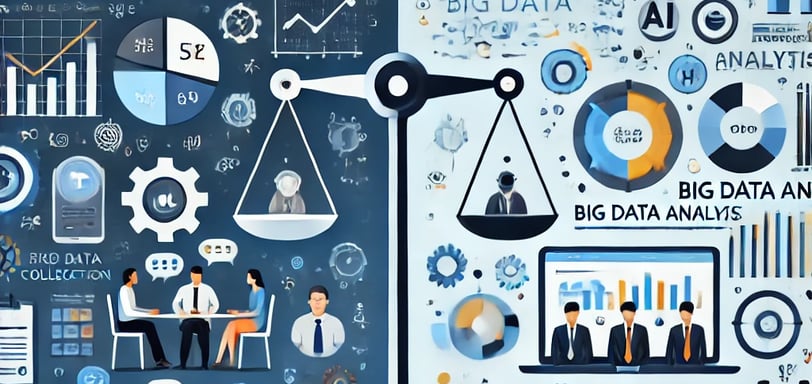AI and Big Data are revolutionizing marketing intelligence: complementarity and limits
Learn how the rise of big data and AI is transforming marketing intelligence and market research. Comparison between traditional methods (Xerfi, Nielsen) and analyses based on real-time big data.
VEILLE MARKETINGMARKETING
Lydie GOYENETCHE
2/2/20253 min read


Marketing intelligence in the age of AI and Big Data
The rise of AI and Big Data in marketing intelligence
Marketing intelligence is an essential component of any business strategy that wants to anticipate market developments and adjust its actions accordingly. The rise of Big Data and artificial intelligence (AI) is profoundly transforming the way companies collect, analyze and use information. While traditional market research relies on proven but static methodologies, AI tools enable dynamic, real-time analysis and large data sets. This evolution is changing not only the ability of companies to identify emerging trends, but also the very nature of the strategic decisions they can make. Today, more than 80% of companies see AI as a key lever to improve their understanding of the market, while the amount of data generated daily reaches dizzying levels, exceeding 2.5 quintillion bytes. This wealth of information, if well exploited, offers new perspectives for refining commercial strategies and anticipating consumer expectations.
The rise of big data in Europe and the changing demand for market research
The rise of Big Data in Europe has profoundly transformed the market research landscape and influenced the demand for skills in strategic marketing. In 2020, the European data management and analytics market was estimated at €35.6 billion and is expected to reach €52 billion in 2024, with an average annual growth rate of 10%. This growth reflects the increasing integration of Big Data into business strategies, especially to refine market analysis and anticipate trends. At the same time, the market research and survey sector has seen more modest growth. Between 2010 and 2019, production in this sector increased by 1% per year in volume, a rate lower than the average for market services, which is 2.9%. This moderate growth can be explained by an evolution in the way data is collected and analyzed, as companies turn more to big data-based approaches for faster and more accurate insights.
This market transformation has had an impact on the strategic marketing professions. Companies are increasingly looking for professionals with data analysis and digital skills. Candidates with a strong specialization in digital marketing or mastery of fields such as SEO, SEA, content marketing or display are particularly popular. This increased demand for specific skills has led to a significant increase in job openings in the sector. For example, between January and September 2022, the volume of job openings in marketing and communication increased by 179% compared to the same period in 2021.
Traditional market research vs. Big Data: a transformation of practices
Market analysis and trend prediction have long relied on traditional studies, such as those offered by Xerfi, Nielsen or GFK. These approaches are based on representative samples, carefully selected and studied through qualitative and quantitative surveys. While they have the advantage of providing detailed and contextualized insights, they suffer from several limitations, particularly in terms of data updates and responsiveness to rapid market changes. Conversely, AI and Big Data make it possible to analyze millions of transactions, online searches, and social media interactions in real time. Tools such as Google AI Platform or IBM Watson process these massive flows of information and identify emerging trends even before they are perceptible via conventional studies. This ability to detect weak signals gives an undeniable competitive advantage to the companies that use them. However, while big data expands the sample studied and reduces the selection bias inherent in small panels, it also presents the challenge of data quality, requiring sophisticated algorithms to filter out noise and ensure relevant analysis.
Review and forum analysis: the key role of AI and NLP
The analysis of customer reviews and specialized forums is another area where AI is revolutionizing marketing intelligence. Traditionally, companies relied on qualitative market analyses, conducted through in-depth interviews or focus groups. These approaches, while informative, are costly, time-consuming, and limited in scale. With the emergence of natural language processing (NLP) technologies, it becomes possible to analyze millions of reviews in minutes, automatically detecting consumers' emotions, trends, and recurring concerns. Google's Natural Language API and IBM's Watson Natural Language Understanding, for example, make it possible to extract precise insights from large corpora of text, identifying key entities, dominant sentiments, and semantic relationships between concepts. Compared to traditional qualitative analytics, these AI-based approaches offer unmatched responsiveness and enable faster decision-making. However, they also raise the question of how to interpret the results: while an AI can spot linguistic patterns and trends, it cannot always contextualize the nuances with the finesse of a human expert.
Global branding and brand adjustment according to the market
In an ever-changing competitive environment, brands need to adjust their branding strategy based on consumer expectations and market dynamics. AI enables continuous monitoring of brand perceptions, through the analysis of trends, social networks and consumer reviews. By quickly identifying brand variations and emerging expectations, companies can adapt their positioning and messaging. This flexibility is particularly valuable for multinationals who have to adjust their communication according to the cultural and economic specificities of each market. At the same time, AI-powered competitive intelligence makes it possible to anticipate rivals' strategies and detect opportunities for differentiation. However, if analysis tools can guide decisions, it is the marketer who must interpret these signals to propose relevant strategic adjustments consistent with the brand's DNA.


EUSKAL CONSEIL
9 rue Iguzki alde
64310 ST PEE SUR NIVELLE
FRANCE
0033782505766
euskalconseil@gmail.com

